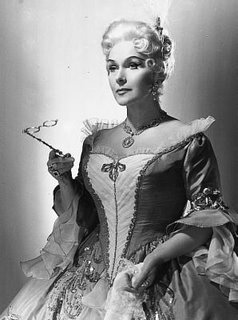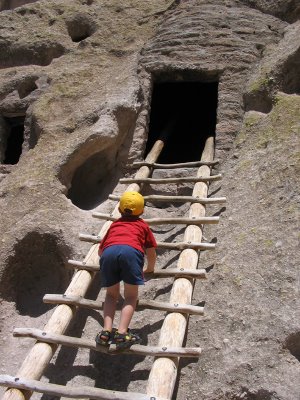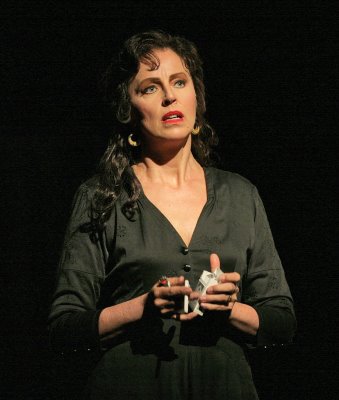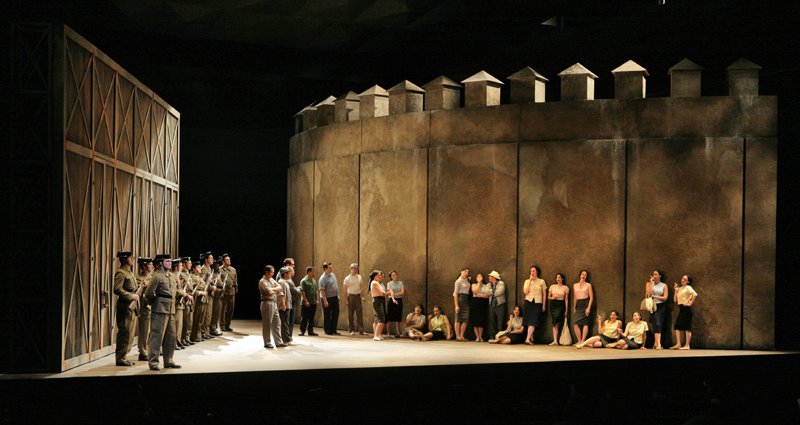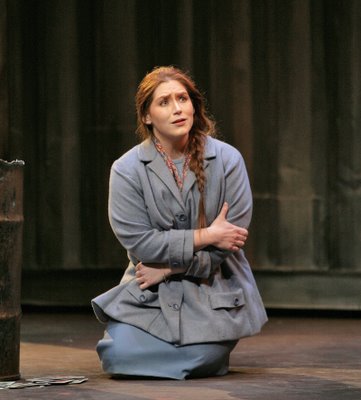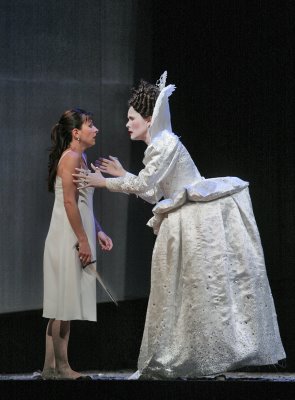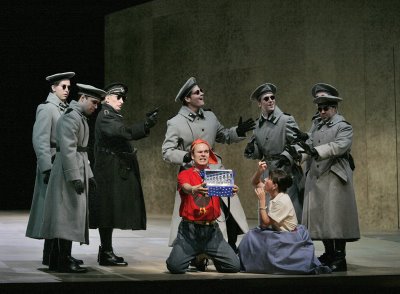Available at Amazon:

Antonio Vivaldi, Motezuma, Il Complesso Barocco, Alan Curtis (released on May 9, 2006)

Antonio Vivaldi, "Montezuma," Dominique Visse, Danielle Borst, Isabelle Poulenard, La Grande Écurie et la Chambre du Roy, Jean-Claude Malgoire (released on September 1, 1993)
|
The rediscovery of Vivaldi the opera composer has been accompanied by an outpouring of recordings, many of them excellent. This recording represents the biggest discovery of them all,
Motezuma, a Vivaldi opera presumed lost forever until a manuscript copy of it was rediscovered by a musicologist named Steffen Voss, in the course of archival research in Berlin.
Hooray, musicology! For the record, this definitive performance certainly replaces the worthy but highly speculative reconstruction, really more a pasticcio, made by
Jean-Claude Malgoire in the 90s. Since that recording -- Malgoire's reworking of other pieces by Vivaldi to fit a surviving copy of the
Motezuma libretto -- is now more or less unavailable, as far as I can tell, the work of Alan Curtis and his fine group, Il Complesso Barocco, is that much more welcome.
When Federico Sardelli and an early music group from Florence, Modo Antiquo, first performed the music from Voss's manuscript last summer, in a concert version at Rotterdam's
De Doelen, Alan Riding told the story of the rediscovery in an article (
Premiere for a lost Vivaldi opera, June 15, 2005) in the
New York Times. There are, as I understand it, 22 arias included in copies of the libretto (all of which are not exactly the same, it should be noted), and the score from the archive of the Berlin Sing-Akademie has only 12 of them. This is a significant find, to be sure, but extensive recreation still had to be carried out by Alan Curtis (Ph.D. in musicology, University of Illinois) and his lead violinist, Alessandro Ciccolini. In fact, according to the liner notes, Ciccolini actually composed a score of the recitatives on this recording and adapted pieces by Vivaldi for the missing arias, in many cases in accordance with previous scholarly findings related to this opera.
In a complicated court case that makes
Lionel Sawkins v. Hyperion seem like child's play, the first staged performance of the opera last September was almost scuttled by a law suit brought by the
Sing-Akademie zu Berlin. Because the Sing-Akademie owned the manuscript score, the lawsuit charged, it had the rights to the performance of the work. As reported in an article (
Vivaldi's `Motezuma' Has Dusseldorf Premiere After Court Win, September 23, 2005) from Bloomberg News, that lawsuit was rejected. The music itself, even if it is on a manuscript page preserved only in one place, is no longer protected by any copyright. It is there for anyone who can make sense of it and perform it.
It may have been better only to record the actual pieces by Vivaldi in the Berlin manuscript, an authentic skeleton versus a reconstruction approximating what we think the whole dinosaur may have been like. An extensive part of Act I is not found in the manuscript. Ciccolini's recitatives and adaptations of other Vivaldi arias are pretty enough but not of much musicological interest. Most brazenly, at the point where the Berlin manuscript begins, in the middle of an aria, Ciccolini has composed, in a convincingly Vivaldian style, an aria based on the 14 existing measures. It is an impressive bit of mimickry, for those interested in this sort of thing.
Il Complesso Barocco is a fine ensemble, and they perform up to their excellent reputation on these three discs. My only minor reservation is about the parts with horn, the overture and the occasional aria ritornelli. The two players do their best, but the lack of accuracy is the most convincing argument for admitting the use of modern instruments in this case. Ciccolini's compositional skill is put to its best use in the ornamentation of A section repeats, most of which are credited to him. The best examples in this recording demonstrate what Baroque ornamentation should be like in informed performance.
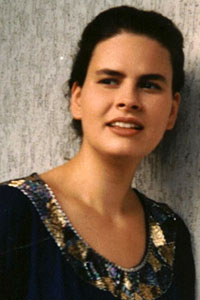
Of the six singers in the strong and well-balanced cast, mezzo-soprano Romina Basso has the most impressive sound, in the trouser role of Ramiro (created for Vivaldi by Angela Zanucchi), the tender younger brother of Fernando (Hernán Cortés). In one of the most beautiful of the rediscovered pieces, the slow aria "Quel rossor ch'in volto miri" (Act II), Basso's voice is equally plangent in the soaring high notes as when it plunges into the low range, as at the end of the B section. The aria is about the younger brother's desire to show clemency toward the Aztecs, tender sentiments expressed by a sensitive youth sighing and yearning for an ideal world. The voice is set against a lovely violin part, with a lilting ritornello, all of which will probably make this aria a recital favorite in the future.
As Teutile, Ramiro's beloved Aztec princess, soprano Roberta Invernizzi was equally sweet, with perhaps the most stunning cadenza on the recording at the end of "Un guardo, oh dio!" (Act II). In the two castrato roles, mezzo-soprano Maite Beaumont (Fernando) was a little rough, with an occasional change of color that suited her masculine role as the conquistador of the Aztecs, and soprano Inga Kalna had a reedy mezzo sound, a little strained at the top, to the strident role of Asprano, the Aztec general. Contralto Marijana Mijanovič brought an impressive and unique sound to the role of Mitrena, Motezuma's queen (created by Vivaldi especially for the unusual voice of Anna Giró, one of his voice students, believed by many to be his mistress, and certainly frequently favored in his operas), although the dark color of Mijanovič's voice was occasionally under pitch at top of range. Bass Vito Priante's Motezuma was forthright, with the right combination of outrage and sadness, marred only by some imprecision of pitch because of a slight wobble.
Some of the new arias are not that noteworthy (Fernando's "I cenni d'un sovrano" in Act I, for example), but others are so beautiful as to make the recording worth buying. Motezuma's "Se prescritta in questo giorno" (Motezuma, Act I) has a great ritornello and interesting melodic turns. The combination of horns and extremely low vocal writing mark Mitrena's "S'impugni la spada," while Asprano's "Brilleran per noi" (Act II) combines a fast A section (with brilliant ornaments on the repeat) and a charming, melancholy B section. In Asprano's "D'ira e furor armato" (Act II), excellent solo trumpet playing provides marvelous interplay with its twin, the powerful vocal part. The best solution would be for Deutsche Grammophon to release a 1-CD excerpted version, with only the rediscovered pieces actually by Vivaldi.
